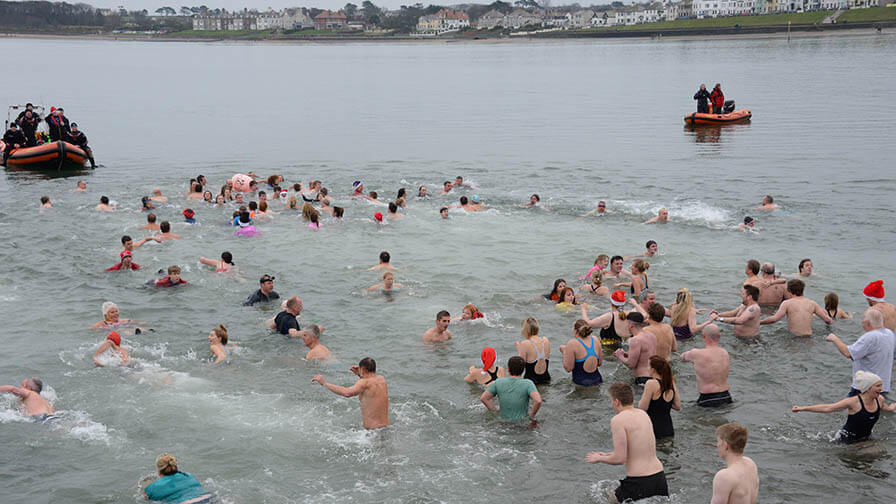Archived
Please note, this page may contain outdated information or subject matter.

It’s become something of a Boxing Day tradition in Northern Ireland… and on Tuesday 26 December, dozens of hardy charity supporters will be taking to the water once again!
The annual Boxing Day Swim returns to Ballyholme Yacht Club in 2017 to raise funds for Action Medical Research.
The event is organised by the SPARKS NI team for Action and chairperson Pamela Ballantine thinks it’ll be a lot of fun: “What better way to wake yourself up on Boxing Day than by taking a brisk dip in the Irish Sea?
“It’s certainly a refreshing charity challenge and the atmosphere always adds to the festivities. We hope to see lots of people there again this year!”
Swimmers will gather at the yacht club from 10.45am for an 11am plunge. For a minimum donation of £10, anyone feeling brave is welcome to join in.
Action’s Community Fundraising Manager for Northern Ireland Janet Balcombe says: “It’s great to see how popular this event has become.
“For many it’s now something of a tradition, but we’re always happy to see brave new swimmers who are up for the challenge.
“We would advise people to wear shoes – just to make the experience a bit more pleasant – and as usual pregnancy is the only excuse for avoiding participation!”
Action Medical Research is a UK-wide charity which funds desperately needed research to tackle the diseases that devastate the lives of so many of our children. It has been funding medical breakthroughs since it began in 1952 including helping to introduce the first polio vaccines in the UK, developing the use of ultrasound in pregnancy and testing the rubella vaccine.
The charity is currently funding research into conditions including asthma, prematurity, epilepsy, meningitis, cerebral palsy, brain cancer and some rare and distressing conditions.
Among the research it is funding is a study at Ulster University led by Professor Kathryn Saunders. More than 100,000 children and young people attend special schools in the UK1-4 and they are more likely than other children to have vision problems, but evidence suggests their problems often go unrecognised and untreated5.
Professor Saunders is investigating the benefits of assessing children’s vision within the familiar environment of their school, sharing the test results clearly with parents, teachers and other people in the children’s lives, and recommending ways to tackle children’s problems in the hope of improving the lives of children and their families.
-ENDS-
References:
- GOV.UK. Official Statistics. Children with special educational needs: an analysis – 2014. Table LA1.8. Special schools: Number and percentage of pupils with statements of SEN or at School Action Plus by type of need. https://www.gov.uk/government/statistics/children-with-special-educational-needs-an-analysis-2014 Website accessed 10 January 2016.
- Statistics & Research Team. Department of Education. Statistical Bulletin 8/2015. Annual enrolments at grant-aided schools in Northern Ireland 2015/16: Basic provisional statistics. Figure 2 - Enrolments in special schools and funded pre-school education in Northern Ireland 2006/07 - 2015/16. 10 December 2015 https://www.deni.gov.uk/sites/default/files/publications/de/statistical-bulletin-annual-enrolments-at-grant-aided-schools-in-Northern-Ireland-2015-16-basic-provisional-statistics.pdf Website accessed 10 January 2016.
- Welsh Government. Statistics for Wales. School census results, 2015. Table 3: Number of pupils, by age group in maintained schools, January 2011-2015 (a). 23 July 2015. http://gov.wales/docs/statistics/2015/150723-school-census-results-2015-en.pdfWebsite accessed 10 January 2016.
- The Scottish Government. Summary statistics for schools in Scotland - No. 6: 2015 Edition. Table 2.1: Schools, pupils, teachers and pupil teacher ratios (PTR) for all publicly funded schools by school sector, 2008 to 2015. http://www.gov.scot/Publications/2015/12/7925/321882#table2.1 Website accessed 10 January 2016.
- Das M et al. Evidence that children with special needs all require visual assessment. Arch Dis Child 2010; 95: 888-92.
NOTES TO EDITORS:
To download a high-res image of the Boxing Day swim, please click on the link below:
https://www.action.org.uk/sites/default/files/downloads/press/boxing_day_swim_2014.jpg
https://www.action.org.uk/sites/default/files/downloads/press/boxing_day_swim.jpg
For more information on Action Medical Research, contact Peter Denton, Fundraising Communications Officer, on:
T: 01403 327480
E: pdenton@action.org.uk
W: www.action.org.uk
Follow us on Twitter at @actionmedres and @amr_events
Like our Facebook page at facebook.com/actionmedres
Follow us on Instagram at @actionmedres and @actionevents
Action Medical Research is a leading UK-wide charity saving and changing children’s lives through medical research. For 65 years we’ve helped pioneer ways to prevent disease and develop treatments benefiting millions of people. Our research has helped to beat polio in the UK, develop ultrasound in pregnancy, fight meningitis and prevent stillbirths. But we urgently need to develop more new treatments and cures for sick babies and children and we can’t do it without you.
Join our fight for little lives today.
Charity reg. nos 208701 and SC039284.
